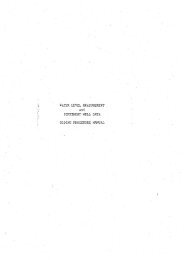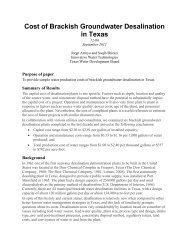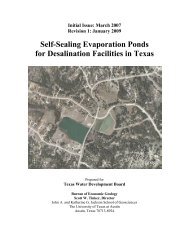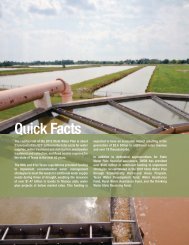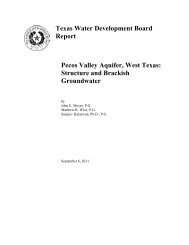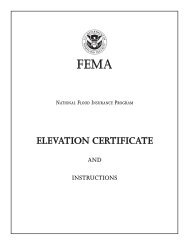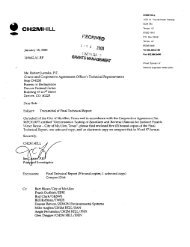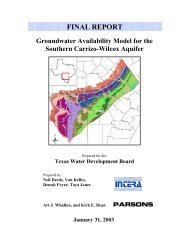Intensive Survey of the Guadalupe River Segment 1806
Intensive Survey of the Guadalupe River Segment 1806
Intensive Survey of the Guadalupe River Segment 1806
You also want an ePaper? Increase the reach of your titles
YUMPU automatically turns print PDFs into web optimized ePapers that Google loves.
increase in <strong>the</strong> importance <strong>of</strong> pollution-tolerant species that feed on FPOM,<br />
and <strong>the</strong> standing crop was not elevated, in contrast to what would be<br />
expected in <strong>the</strong> presence <strong>of</strong> organic pollution.<br />
Changes in species composition and community trophic structure observed<br />
through <strong>the</strong> reservoir were attributed to natural, longitudinal succession<br />
ra<strong>the</strong>r than <strong>the</strong> effects <strong>of</strong> artificial organic enrichment. Overall biological<br />
stability in <strong>the</strong> reservoir, as indicated by macrobenthic community structure,<br />
was judged to be good.<br />
The river 200 m below Flat Rock Dam, <strong>1806</strong>.0223 (Station J), exhibited <strong>the</strong><br />
highest diversity and equitability and <strong>the</strong> second highest species richness in<br />
<strong>the</strong> study, and clean water mayflies were well represented (9 species; 14.1%<br />
<strong>of</strong> <strong>the</strong> community), indicating stable environmental conditions. Community<br />
structure resembled that below Ingram Lake Dam, in that both stations had<br />
large standing crops, with FPOM comprising <strong>the</strong> primary food material as<br />
indicated by community trophic structure. These common characteristics<br />
apparently result from influences <strong>of</strong> <strong>the</strong> small mainstream reservoirs<br />
immediately upstream from each station. However, decreased importance <strong>of</strong><br />
filterers toge<strong>the</strong>r v/ith increased importance <strong>of</strong> ga<strong>the</strong>rers indicated that a<br />
greater portion <strong>of</strong> <strong>the</strong> FPOM was in sedimented ra<strong>the</strong>r than suspended form<br />
below Flat Rock Dam. Also, grazers were considerably more important below<br />
Flat Rock Dam, indicating a greater prevalence <strong>of</strong> periphyton, perhaps due in<br />
part to nutrient inputs from <strong>the</strong> City <strong>of</strong> Kerrville.<br />
The macrobenthic community at Wharton Road, <strong>1806</strong>.0220 (Station K), was also<br />
stable as indicated by very high species richness, diversity, and equitability,<br />
and strong representation by mayflies (9 species; 14.6% <strong>of</strong> <strong>the</strong> community).<br />
A considerable shift in community trophic structure, with FPOM feeders<br />
decreasing and grazers increasing in importance, reflected a continuing<br />
longitudinal trend toward increasing prevalence <strong>of</strong> periphyton as <strong>the</strong> primary<br />
food source. This fur<strong>the</strong>r suggests slightly elevated primary production,<br />
possibly as a result <strong>of</strong> periodic discharges <strong>of</strong> nutrients from Kerrville.<br />
Tributary Water Ouality<br />
Dissolved oxygen was 8.1 mg/L in Johnson Creek (Station R) and 9.7 in<br />
Cypress Creek (Station V) when monitored (Table 8). All <strong>of</strong> <strong>the</strong> dissolved<br />
oxygen levels from <strong>the</strong> three stations on Third Creek (Stations S, T, and U)<br />
remained above 7.0 mg/L and <strong>the</strong> narrow ranges between minima and maximum<br />
levels indicates stability in water quality. Levels <strong>of</strong> pH at <strong>the</strong> three<br />
tributary streams were similar to those <strong>of</strong> <strong>the</strong> mainstream <strong>Guadalupe</strong> <strong>River</strong><br />
stations and water temperature was less than 22°C.<br />
CBOD5 and CBOD2q levels were very low in Johnson and Cypress Creeks<br />
(< 1.0 mg/L), but were slightly elevated in Third Creek (Table 9). Levels<br />
for <strong>the</strong>se two parameters were highest at <strong>the</strong> uppermost station on Third<br />
Creek (Station S). In fact <strong>the</strong>y were <strong>the</strong> highest <strong>of</strong> any measured on <strong>the</strong><br />
survey. O<strong>the</strong>r parameters at this station that were also <strong>the</strong> highest measured<br />
on <strong>the</strong> survey include orthophosphorus (0.09 mg/L), total phosphorus (0.18<br />
12




